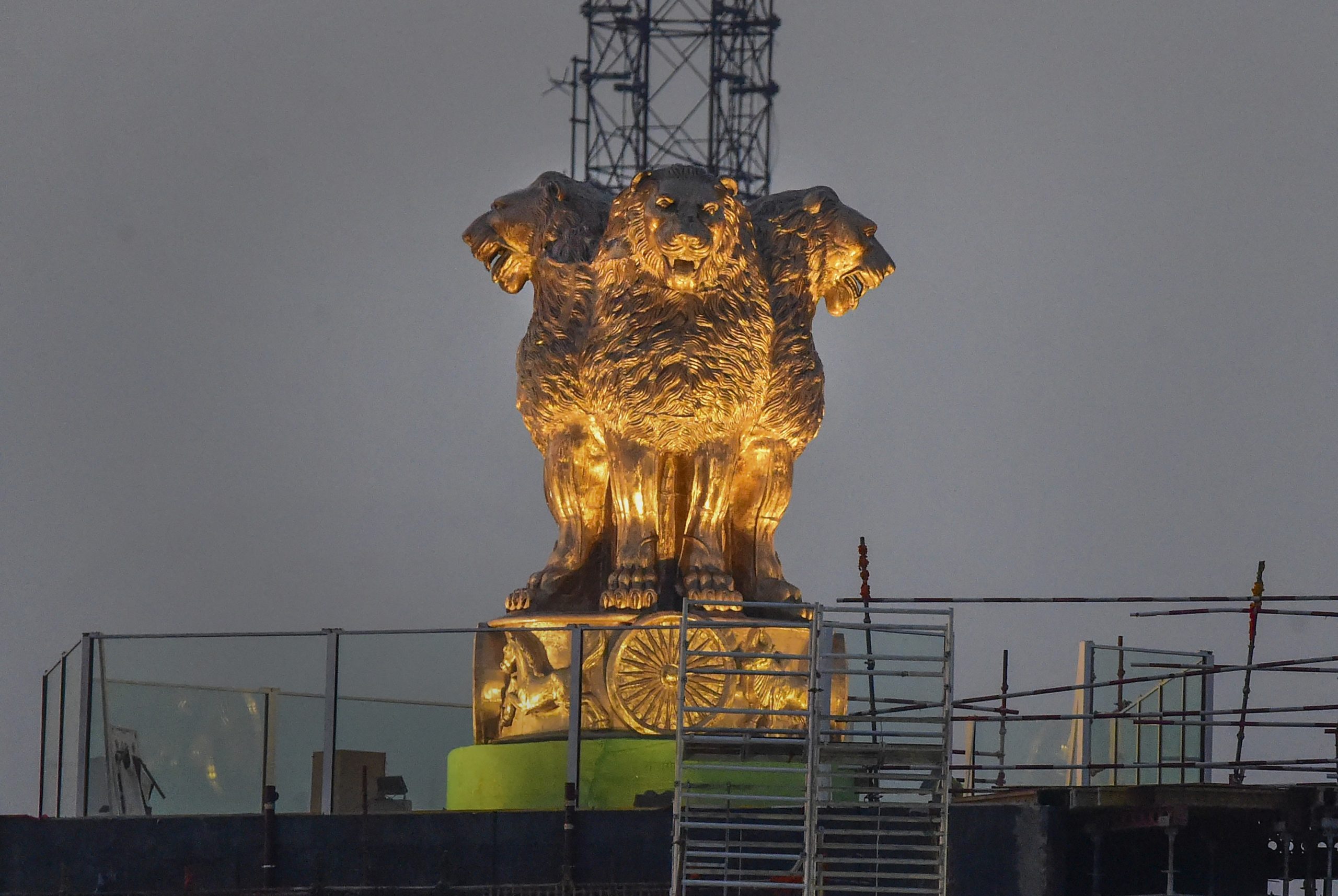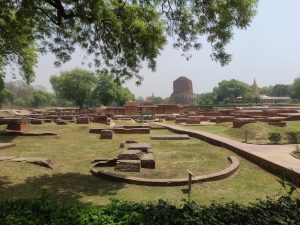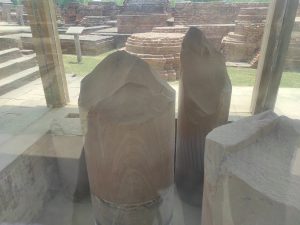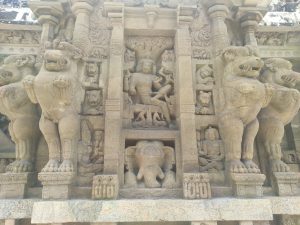Is the giant Sarnath lion replica unveiled by PM Modi atop the new Parliament building ugly? Also, a look at the Ashokan site near Varanasi.

The recently unveiled national emblem, a 'replica' of the Sarnath lion capital, on the roof of the new Parliament building in Delhi on 12 July (PTI)
The controversy over the national emblem unveiled atop the new Parliament building by Prime Minister Narendra Modi on 11 July has put the spotlight on the ancient site of Sarnath near Varanasi, lions in Indian art and even sculpture-making.
RH Kulkarni, Professor in the Department of Art History in the Karnataka Chitrakala Parishath told South First that many of those commenting on the Sarnath lion and the new emblem replica are not aware of the technicalities of sculpture-making. “This is a mammoth-sized sculpture and meant to be seen from a distance. Sculptures which are at eye level and those much larger than us have a different methodology of carving,” the art historian said.
Opposition leaders have alleged that the lions in the new sculpture are too aggressive. Trinamool Congress MP Jawhar Sircar, a former Prasar Bharati CEO, tweeted: “Insult to our national symbol, the majestic Ashokan Lions … Snarling … Shame! Change it immediately!” Jairam Ramesh, Congress general secretary in charge of communications, too criticised the replica of the national emblem.
To completely change the character and nature of the lions on Ashoka’s pillar at Sarnath is nothing but a brazen insult to India’s National Symbol! pic.twitter.com/JJurRmPN6O
— Jairam Ramesh (@Jairam_Ramesh) July 12, 2022
Meanwhile, AIMIM MP Asaduddin Owaisi criticised the unveiling, claiming it violated constitutional norms.
Union Minister Hardeep Singh Puri, who was with Prime Minister Modi during the unveiling of the national emblem, however, tweeted that it was a matter of perspective and added: “If the Sarnath emblem was to be scaled up or the emblem on the new Parliament building is reduced to that size there would not be any difference.”
If an exact replica of the original were to be placed on the new building, it would barely be visible beyond the peripheral rail.
The ‘experts’ should also know that the original placed in Sarnath is at ground level while the new emblem is at a height of 33 mtrs from ground. pic.twitter.com/JLxMMMAq80
— Hardeep Singh Puri (@HardeepSPuri) July 12, 2022
Art historian Srinivas Sistla from Andhra University, Visakhapatnam, agreed with those criticising the sculpture and told South First that the emblem atop the new Parliament building is “definitely distorted”. “The new emblem is not a true replica of the Sarnath capital lion and is disproportionate. Just take a look at the mane. In the Sarnath pillar capital, it is so beautifully moulded,” he said.
However, Kulkarni noted that the sculpture’s appearance would also be modified by the artist according to the size. “Take the Gomateswhara in Shravanabelagola, which is 50+ feet tall. If you compare its anatomy and the aesthetic value with a smaller sculpture carved in limestone or soapstone of the Hoysala period, there will be a stark difference. The smaller sculpture will always look much more beautiful and sophisticated,” Kulkarni added.

Dhamekh Stupa in Sarnath. “’Here [in Sarnath] the Tathagata set rolling the unexcelled wheel of the Dhamma,” the Buddha told his disciple Ananda, according to the Mahaparinirvana Sutta, part of the Pali canon (Prasanna RS)
Sarnath is one of the four places that the Buddha asked his disciples to visit. According to Buddhist tradition, Gautama, after his enlightenment, gave his initial sermon in Sarnath.
The Dhamekh Stupa, which has bricks from the Mauryan era, is believed to commemorate the place where he instructed his first five disciples.
Not far from the Dhamekh Stupa is the place where the lion pillar was originally located. Built in the 3rd century BCE, it has an edict of Mauryan emperor Ashoka.

Fragments of a 15.25 metre-high Ashokan pillar with the lion capital (3rd century BCE) made of highly polished Chunar sandstone near the Dhamekh stupa. The pillar has an Ashokan edict in which the emperor warns monks and nuns against creating any division in the Buddhist Sangha (Prasanna RS)
The site currently has only a few fragments and the lion capital can be seen in the nearby Archaeological Survey of India’s site museum in Sarnath.
Near the fragments of the pillar is the Dharmarajika stupa, built by Ashoka to enshrine Buddha’s relics.
Art historian Sistla added that lions have also been part of the Jain (where it is associated with a Tirthankara) and Hindu traditions.
In South India, we can see lions in sculptural form from at least the Kadamba period (around 300 CE). One of the earliest such sculptures, from Kodlu in Karnataka, is of a zoomorphic Narasimha (the Vishnu avatara), Kulkarni noted.
From the Early Chalukya period, lions are seen in many places including Badami’s Upper Sivalaya (Karnataka) and Alampur (Andhra Pradesh) (6th–7th centuries CE).
“Alampur has four lions sitting back to back, a very unique representation,” Sistla said. While it is seen in the Mauryan times and there are Gupta period copies, such a sculpture becomes rare later, the art historian pointed out.
Many of the Pallavas, who mostly ruled from Kanchipuram in South India, have simha (lion) in their names—Simhavishnu, Narasimhavarman, Rajasimha, et al. Lions thus were synonymous with the royal family.

Rampant lion and Dakshinmoorthy sculptures in the Kailasanatha temple, Kanchipuram, Tamil Nadu. The foundation inscription, which can be seen below the elephant in Pallava Grantha script, gives the temple’s original name: Rajasimha Pallaveswaram (Prasanna RS)
In Pallava temples after Mahendravarman I (early 7th century CE), most of the pillars stand on lions.
For instance, rampant lions at the base of pillars are considered a signature of Rajasimha.
“When we go to Kanchipuram and look at the Kailasanatha temple (built by Rajasimha), there are more lions than even sculptures of deities,” Kulkarni quipped.
Incidentally, the Kanchipuram Kailasanatha (built around 700 CE) is regarded by many art historians as one of the most beautiful temples anywhere in India.
Later, during the period of the Vijayanagara dynasty (established in 14th century CE), lions in sculptural form in South India became ubiquitous. “There are umpteen numbers of lions sitting on their haunches in Vijayanagara monuments,” art historian Sistla said.

Apr 29, 2024

Apr 29, 2024

Apr 29, 2024

Apr 29, 2024

Apr 29, 2024

Apr 29, 2024